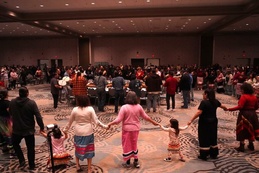The rush to Biomass
March 7, 2010
The Rush to BiomassEnvironmentalists plead: ‘Slow down!’
By Anne Stanton
Al Gore wrote recently that we can’t wish away climate change. “We are continuing to dump 90 million tons of global-warming pollution every 24 hours into the atmosphere—as if it were an open sewer,” he wrote in a New York Times editorial.
Environmentalists have long embraced Gore’s message. But the alternatives to coal? Not an easy answer. Arguments are flaring nationally because alternatives can also poison, upset, and degrade the environment.
Traverse City is no different. A proposal by Traverse City Light and Power (TCL&P) to build a biomass plant in town was largely opposed in two heavily attended public meetings held two weeks ago. If built, the $30 million plant would burn primarily wood chips culled from the forests in the Grand Traverse region. It would also compete with a number of other current or proposed biomass plants in the region for sources of wood -- a situation which opponents say would put too much stress on Northern Michigan’s forests.
Opponents include Jeff Gibbs, who is working on the documentary, Planet of the Humans. “Burning our forests for energy is a terrible choice, it’s the absolute wrong road to travel,” he said.
Biomass supporters include people who are usually on Gibbs’ side: Traverse City Mayor Chris Bzdok, who is an environmental attorney, and Jim Carruthers, an activist and city commissioner who sits on the TCL&P board. Check out Bzdok’s planfortc.com to read their spirited discussion.
Carruthers said using the woods for energy makes sense for all kinds of reasons: the woods are already managed as a resource, it means new jobs, and it would keep $18 million in energy dollars here. The resource is also renewable.
M’Lynn Hartwell can see why former allies are having trouble agreeing. “I was originally a proponent of biomass too, just like I was for corn-based ethanol. But the science isn’t bearing it out,” she said.
Meanwhile, two major environmental groups haven’t yet taken an up or down position, but are urging TCL&P to slow down the decision process and fully analyze alternatives.
THE PLAN
Currently, all of TCL&P’s energy comes from coal-fired power plants, except for 1% of wind energy. TCL&P customers pay the lowest electric rates around, but they will surely rise as the utility is weaned off coal’s rock bottom cost of 5 cents per kilowatt hour, said Ed Rice, TCL&P’s executive director, who looks and speaks a bit like TV star Ed Asner.
One of TCL&P’s major suppliers put the utility on notice to find a new supply of energy within the next four to five years. Rice said it will take about that long to build a new generating facility, and TCL&P would prefer, in the future, for the area to keep the $18 million it now pays out to supply its 11,400 customers.
The utility is pursuing an ambitious “30 by 20” plan, meaning that TCL&P hopes to produce 30% of its power from renewable energy by 2020. Locally, the percentages would break down this way: coal, 55%; biomass, 20%; wind 6%; and landfill gas, 4%. The remaining 15% is undetermined.
The audience at both of the recent TCL&P public hearings was broken into several study groups. Participants generally applauded the utility’s goal, although a few questioned why it wants to exceed the state’s 10% renewable energy requirement. Some were angry that the public was brought into the discussion so late.
“You meet, meet, meet, and you’ve made up your minds on biomass, and now you’re going to ask us what we think? Wait a minute! How long have you been talking about it? This is big! This is a really a big thing,” said Sandy Robey of Traverse City.
A number of audience members pelted the utility with hard-hitting questions about biomass, and some stalked out, frustrated by the meeting’s process. TCL&P would not to respond to concerns, opting to deliver a synthesis of the issues on April 7. The board will vote on the biomass option on April 13. But Hartwell says there is absolutely no need for such a fast decision.
Many applauded TCL&P’s decision to strive for an ambitious renewable portfolio and to involve the community. Interestingly, relatively few commented on the potential rate spike in their monthly bill. TCL&P will meet with environmental groups to gain their input before the April 7 meeting.
It’s impossible to characterize the range of opinions, but there was a clear consensus to explore other options before investing $30 million into a biomass plant.
Here is a summary of the available energy alternatives with the costs per kilowatt hour for each. The utility needs a 75 megawatt capacity to operate.
NATURAL GAS AND WIND POWER
Wind: 10.5 cents
Natural gas: 11 to 15 cents
This solution pairs up natural gas and wind power, because wind power alone can’t provide a baseload—meaning, a steady, guaranteed supply of power supply at all times. There is no practical way to store power from a windmill. And outside power sources can’t fill in during the down times, Rice said, adding the national electrical grid is in desperate need of an overhaul.
One solution offered to the Express came from Marty Lagina, an energy veteran whose newest project is Stoney Farms, a windmill farm in southern Missaukee County.
Lagina said that natural gas backing up wind power would be a great way to go.
“Natural gas is very low carbon, and it’s a clean fuel. It’s not carbon neutral, but it’s the best fossil fuel and it’s here in Northern Michigan.”
Lagina explained that vast supplies of natural gas are opening up in Pennsylvania, New York, West Virginia, Texas, and Arkansas. He believes that biomass, however, does belong in the energy mix.
In fact, TCL&P already owns a natural gas plant in Kalkaska County, which has the capacity to produce up to 37 megawatts for the utility. It runs at a 40% capacity because the price isn’t competitive, due to an expensive 10-year natural gas contract that went into place in 2002, Rice said.
Most of the plant’s power goes to Mancelona and Grayling, with a small fraction flowing to Traverse City ratepayers, he said.
Rice said the biggest drawback to natural gas is its price volatility.
“Back in the early ‘90s, there was the same type of abundance that Marty’s talking about, and companies built big generating plants in Michigan. The prices skyrocketed, and those plants had to be abandoned and sold off.”
Hartwell believes Rice’s reference to the cost of natural gas may be off.
“Ed’s comment about gas cost being volatile, is true if you buy on the spot market, but with long-term contracts available, I have heard of deals being made that are as much as 15% below the normal wholesale rate paid by utilities.”
OPPOSITION
Jim Carruthers opposes natural gas because it’s still a fossil fuel and emits carbon.
“The environmental movement is trying to get out of fossil fuels and natural gas is a fossil fuel,” he said.
But Greg Reisig, chairman of Northern Michigan Environmental Action Council (NMEAC), wants to explore this idea. Although natural gas is a fossil fuel, it has half the emissions of coal. A wind/natural gas solution could serve as a bridge to something better. Given the ongoing increase in natural gas supplies, it might be possible to lock into a lower cost, multi-year contract when TCL&P’s current natural gas supply contract expires in two years.
“We are well aware that the energy landscape will be very different in a very few years, so why commit to this big old biomass plant? It’s a huge investment for $30 million and a technology that may be obsolete in three to five years,” Reisig said.
TCL&P already plans to buy power from Lagina’s five windmills to produce 10 megawatts per year (two per unit). Some residents want the utility to go for more.
The cost of wind could go lower if TCL&P operated its own windmills, but locating a windmill isn’t easy, Rice said. Presently there is fierce opposition to putting windmills in Lake Michigan in an area ranging from Pentwater to Ludington, where wind velocity is highest. TCL&P had proposed a windmill in Charlevoix, but scrapped plans because of airport restrictions.
Of all the options besides biomass, Rice is the most amenable to this proposal. He said that a natural gas plant could be sited at Grand Traverse Commons—a location that would allow hot water to be siphoned to the Commons, the local hospital, or local schools, making the option more affordable.
WOOD GASIFICATION BIOMASS
TCL&P plans to hire Heat Transfer International (HTI) of Grand Rapids to build a 10 megawatt plant. In turn, HTI has agreed to sell power to the utility at 8.2 cents per kilowatt hour for 10 years, Rice said.
The plant would use a process called wood gasification. Instead of burning the wood directly for energy, it first burns the wood chips slowly to make heat. Gases are driven off and collected into a chamber. Hot water, a byproduct, could help heat businesses or schools, which have boilers.
Rice said the gasification process would reduce particulate levels to very small amounts.
Yet those who live in a nearby low-income neighborhood say they don’t want the noise and exhaust from the semi-trucks carrying wood. They fear the particulate, too tiny to be regulated, might cause asthma, breathing problems, or even cancer.
Gibbs claimed that the $30 million gasification plant is too risky. HTI has experience with gasification, but has never built a biomass gassification plant of this magnitude.
“Gasification is as old as the hills, but there hasn’t been a proven plant generating the quantity of megawatts they’re talking about. I’m afraid they’re buying a $30 million boat anchor,” said a former biomass plant manager, who requested anonymity.
THE PRICE FACTOR
Biomass is the cheapest renewable, but there are caveats, said Hartwell.
“The cost of biomass without subsidies will be substantially higher, and the subsidies will expire in less than three years. The cost of wood in a free market for a diminishing resource will also drive wood up.”
Price won’t be an issue for awhile, Rice said, since HVI has locked in its price for 10 years.
Rice also said there is plenty of wood for this plant, which will come from a 75-mile radius around Traverse City. The biomass plant will burn 100,000 tons per year, which requires a harvest of 77,000 acres out of 1.2 million acres available. They won’t clear cut trees, but take tree tops, scrap wood, and unmarketable trees.
These figures come from Robert Froese, a Michigan Tech forestry professor who advised the TCL&P. The 1.2 million figure only includes available public acreage and half of wooded acreage held in private ownership.
Marvin Roberson, Michigan Sierra Club’s forest ecologist, said that Froese’s figures are unrealistic, because they assume a rate of growth that you only get with high quality, hardwood forests. Yet much of public land is comprised of mono-plantations of poplars and red pine. He also debated whether private owners would be willing to have their land harvested.
Roberson also said that burning wood is an unwise use of lumber.
“There is no way to get a worse return than burning wood. It’s worth more as anything else—making pulp, paper and furniture is worth more. We are not opposing cutting of wood, but if you’re going to cut wood, let’s get the best possible return.”
Froese is also consulting with other biomass projects, and giving them the same numbers. “Yet they are all going to be collecting wood out of the same basket,” he said.
MULTIPLE PLANTS
Added Reisig: “There are multiple biomass plants. What about the one they’re going to build in Mancelona? We have one in Cadillac, one in Grayling, one in Hillman, maybe one in Frankfort -- no one knows for sure. There is real concern about the larger plants in the U.P. that will consume millions of tons of wood, like in Kinross, a plant for cellulosic ethanol. There’s also concern about the Wolverine plant in Rogers City, which had originally been proposed as a coal plant, but now has plans for up to 30% biomass.
“Each plant needs its own supply. Once they put them up, you need the supply. Who’s supervising them? I don’t know. This has statewide ramifications, and it seems the state energy office needs to address this. There’s a rush to biomass—it’s legally the easiest to do and still be called ‘renewable.’ You cut down a tree, a new tree will grow up. But what are the consequences, what are the impacts on water quality, emissions, the forests?”
Yet, proponents say biomass is renewable. It emits 1.5 times the amount of CO2 as coal for the same megawatts, but is considered offset by new trees that absorb carbon.
Critics say that burning wood ignores the time scale of regenerating forests. They note that it takes a few minutes to burn a tree, but decades to grow a new one. Additionally, it takes fossil fuel to drive a truck in the forest to get the wood, to use a chain saw, and to operate a wood chipper.
“When you add all that in, it’s not carbon neutral, like Traverse City Light and Power says on its pie chart. They have a zero there. But what’s the real carbon footprint? There is question after question,” Reisig said.
A typical 10 megawatt wood burning power plant emits about 100,000 tons of carbon dioxide per year. Gibbs said that the federal government is subsidizing biomass plants, despite the fact that emissions will hasten climate change.
Counters Rice; “It gets back to what the state law says and what the federal law says. If they’ve done all the scientific investigation—and I know a lot of people say we don’t want to believe the government, but when do we stop saying, ‘We don’t like that law and we’ll only adhere to what we believe is true.’ The government tells us what they’ll allow and what they won’t allow. Their rules say that it’s zero, and it’s an offset if you burn a tree and replace it with one that grows in the human lifetime.”
THE PROFIT MOTIVE
What’s easier for timber companies? To glean scrap wood from 77,000 acres or to cut down the equivalent amount of trees standing on 1,000 acres?
“These guys that do this are outdoorsmen, a lot of them are environmental, but the bottom line is they are running a business and they’ve gotta make a profit,” said former biomass plant manager. “So they’re going to harvest the easiest wood they possibly can at the lowest cost to them. It costs a lot of money to produce wood chips. It’s not a free deal.”
Rice said the board would “make absolutely sure we’d have a permanent staff forester to oversee that process. If you turn it loose to the industry, you can run into problems. We don’t want that. Our mission is to be environmentally conscious.
“The way the legislation is written, if any entity is cutting on private or state land, they have to follow the state rules to be qualified as a renewable generator. You can’t cut down all the trees, or you’d risk losing certification as a renewable energy source.”
But is it realistic to expect one person to oversee a harvesting operation of 100,000 tons a year? Reisig asked.
Finally, no on one really knows the impact of taking scrap wood from the forest over time. Rotting wood restores nutrients to the soil and provides food and shelter for the bugs and “critters” of the forest.
Rice said, however, that managing a forest by removing scrap wood “enhances the forest” and reduces the risk of sustained forest fires. “I live here, too, and I wouldn’t do anything to harm the woods.”
HYRDO POWER
Electricity generated by dams costs 15 to 18 cents per kilowatt hour.
A decision has already been made to remove the four dams on the Boardman River, and Rice doesn’t want to revisit the issue. But several participants believe hydro power makes sense.
Those on the pro-dam side argue that members of the review committee were predisposed against the dams. They fear that removing the dams will increase the chance of flooding homes built on the river. A dam could provide a source of renewable energy (the three dams formerly produced 2 megawatts per year). They believe the city should take up businessman Charles Peterson on his offer to rebuild the dams, because it would cost taxpayers nothing. They point to the Elk Rapids dam, which is privately owned and operated. TCL&P doesn’t really know how much it would cost to rebuild the dam or its potential power production because it never brought in an expert, Reisig said.
Those in favor of removing the dams say the energy they produce would be small, especially in light of the millions it would take to fix them. Peterson has no experience in dams, and Rice said it’s too risky to put faith in his expertise; the river could flood downtown Traverse City if a dam broke. Environmental groups have fought for dam removal so that the river could return its natural state and once again support cold-water trout populations.
Mike Delp, an avid fly fisherman, said he has mixed feelings. He fears that once Boardman River is restored, the DEQ will plant steelhead trout, which will kill off other fish populations. Downstate fishermen will also crowd the banks and degrade the river bank.
SOLAR AND CONSERVATION
As one of the most expensive options, solar (which costs 18 to 25 cents per kilowatt hour to produce) has received little discussion. But Reisig suggested there’s potential. In Ann Arbor, 20% of rooftops are equipped with solar panels. The credit goes partly to David Konkle, the city’s former energy coordinator of 20 years.
And that leads into the final and what many people believe is the ultimate answer: Conserve! What if you took a small fraction of the $30 million and used it to help the 11,400 ratepayers become 20% more efficient? (TCL&P has $25 million in reserves.)
“I’d love to see more on ‘nega-watts’--conservation and efficiency offsets production,” Hartwell said. “The reality is, we can quite comfortably replace the biomass plant if we used energy more deliberately. In the end we must learn to conserve. The earth does not contain enough of any burnable fuel to continue at the rate we are currently consuming.”
She would like to see a “green lifestyle” coordinator, who would oversee energy conservation and efficiency, as well as bike lanes, pedestrian crossings, and all of the things that contribute to a quality of life.
Carruthers is skeptical. By replacing his lights and appliances, he has pared his electric bill to $20 a month, but wishes more would do the same. TCL&P, after all, will tell you exactly how to reduce energy with their $10 energy audits. “Call them!” he said.
Gibbs gave this advice: “People need to fall in love with nature again and make their decisions that way. Healthy people helping the planet. That’s the good life.”
Trending

Winter Break at the Library
Trying to keep the kids busy while school is out? Head to the library! Dec. 22, take your 12+ tweens and teens to the Mesick… Read More >>
Umbo Is Coming...to The Little Fleet
Winter isn’t just coming—it’s already here. But if you want a break from the December blues, head to The L… Read More >>
GTB Starting the Year with Tradition
The Grand Traverse Band of Ottawa and Chippewa Indians hosts the Kchi Wiikwedong Anishinaabek Maawnjidowin Round Dance on Ja… Read More >>


